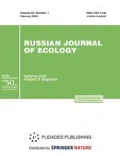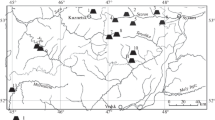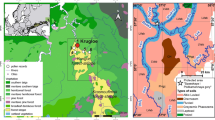Abstract
Steppes at the northern limit of their distribution are a convenient object for studying climate-induced modifications of the environment, being sensitive to regional climate changes. Over the past 46–47 years, herbaceous vegetation in the study steppe areas has been replaced by shrubs and trees. Petrophytic steppes on hilltops and stony knolls, where conditions are not favorable for tree growth, has proved to be more resistant to such changes. In these habitats, however, the influence of surrounding forest phytocenoses has also resulted in a gradual decrease in the proportions of species from the steppe and forest–steppe floras in the structure of communities and the invasion by species typical of forest vegetation.
Similar content being viewed by others
References
Agafonov, L.I. and Kukarskikh, V.V., Climate changes in the past century and radial increment of pine in the Southern Ural steppe, Russ. J. Ecol., 2008, vol. 39, no. 3, pp. 160–167.
Anenkhonov, O.A., Changes in the cenoflora of dark conifer forests in the northern Baikal region under conditions of current climate warming, Geogr. Prir. Resur., 2009, no. 4, pp. 62–66.
Anenkhonov, O.A., Studies on the climatogenic dynamics of vegetation: Prerequisites, approaches, and prospects, Izv. Irkutsk. Gos. Univ., Ser. Biol. Ecol., 2012, vol. 5, no. 3, pp. 3–7.
Balandin, S.V., Dynamics of steppe vegetation in the Uktus Mountains, the Middle Urals, Bot. Zh., 2001, vol. 86, no. 5, pp. 103–110.
Batchaeva, O.M., Zakharov, A.A., and Onipchenko, V.G., Dependence of plant distribution on soil depth in alpine phytocenoses of the Teberda Nature Reserve, Byull. Mosk O-va Ispyt. Prir., Otd. Biol., 2003, vol. 108, no. 4, pp. 53–57.
Bobrovskaya, N.I. and Kazantseva, T.I., Transformation of meadow steppes under the impact of climatic and anthropogenic factors, Nauka Tsentr. Rossii, 2012, no. 2S, pp. 222–227.
Borovik, L.P. and Borovik, E.N., The problem of steppe conservation regime in nature reserves: The example of the Strel’tsovskaya Steppe, Stepnoi Byull., 2006, no. 20, pp. 29–33.
Czerepanov, S.K., Vascular Plants of Russia and Adjacent States (the Former USSR), St. Petersburg: Mir i Sem’ya, 1995; Cambridge: Cambridge Univ. Press, 2007.
Gafurov, F.G., Pochvy Sverdlovskoi oblasti (Soils of Sverdlovsk Oblast), Yekaterinburg: Ural. Gos. Univ., 2008.
Golding, D.L. and Swanson, R.H., Snow distribution patterns in clearings and adjacent forest, Water Resour. Res., 1986, vol. 22, no. 13, pp. 1931–1940.
Gorchakovsky, P.L., S.I. Korzhinskii and some problems in phytogeography of the Urals, Bot. Zh., 1962, vol. 47, no. 6, pp. 886–889.
Gorchakovsky, P.L. and Romakhina, N.P., Northern outposts of steppe vegetation in the Ural Foothills, Zap. Sverdlovsk. Otd. Vses. Bot. O-va, 1966, no. 4, pp. 37–51.
Gorchakovsky, P.L., The Krasnoufimskaya Steppe: A botanical phenomenon in the Cisural region, Bot. Zh., 1967, vol. 52, no. 11, pp. 1574–1591.
Kazantseva, T.I., Bobrovskaya, N.I., Pashchenko, A.I., and Tishchenko, V.V., Dynamics of steppe vegetation in a 100-year fallow area of the Kamennaya Steppe, Voronezh Oblast, Bot. Zh., 2008, vol. 93, no. 4, pp. 620–633.
Kharuk, V.I., Im, S.T., Ranson, K.J., and Naurzbaev, M.M., Forest–tundra larch forests and climatic trends, Russ. J. Ecol., 2006, vol. 37, no. 5, pp. 291–298.
Knyazev, M.S., Zolotareva, N.V., and Podgaevskaya, E.N., Relict fragments of forest–steppe in the Transural region, Bot. Zh., 2012, vol. 97, no. 10, pp. 28–44.
Korzhinskii, S.I., The northern boundary of the chernozem steppe region in the eastern zone of European Russia from the standpoint of botanical geography and soil science: 2. Phytotopographic studies in Simbirsk, Samara, Ufa, Perm, and, in part, Vyatka provinces, Tr. Obshch. Estestvoisp. Imp. Kazan. Univ., 1891, vol. 22, no. 6, pp. 1–201.
Krivobokov, L.V. and Anenkhonov, O.A., Tendencies of changes in the floristic composition of steppe vegetation in the northern Baikal region under climate warming, Rastit. Mir Aziat. Rossii, 2010, no. 2 (6), pp. 17–21.
Krylov, P.N., Materials on the flora of Perm province, part 1, Tr. Obshch. Estestvoisp. Imp. Kazan. Univ., 1878, vol. 6, no. 6, pp. 1–110.
Kudryavtsev, A.Yu., Vegetation restoration dynamics in the forest–steppe system of the middle Volga region, Russ. J. Ecol., 2007, vol. 38, no. 5, pp. 299–305.
Kulikov, P.V., Zolotareva, N.V., and Podgaevskaya, E.N., Endemichnye rasteniya Urala vo flore Sverdlovskoi oblasti (Endemic Plants of the Urals in the Flora of Sverdlovsk Oblast), Yekaterinburg: Goshchitskii, 2013.
Magurran, A.E., Ecological Diversity and Its Measurement, Princeton, NJ: Princeton Univ. Press, 1988. Translated under the title Ekologicheskoe raznoobrazie i ego izmerenie, Moscow: Mir, 1992.
Maslov, A.A., Fluctuations and successions in forest communities against the background of climate change, Izv. Samarsk. Nauch. Tsentra Ross. Akad. Nauk, 2012, vol. 14, no. 1 (5), pp. 1316–1319.
Metody dendrokhronologii (Dendrochronological Methods), part 1: Osnovy dendrokhronologii. Sbor i poluchenie drevesno-kol’tsevoi informatsii (Basic Dendrochronology: Collection and Acquisition of Tree-Ring Information), Shiyatov, S.G., Vaganov, E.A., Kirdyanov, A.V., Eds., Krasnoyarsk: KrasGU, 2000.
Mirkin, B.M., Naumova, L.G., and Solomeshch, A.I., Sovremennaya nauka o rastitel’nosti (The Modern Science of Vegetation), Moscow: Logos, 2000.
Moiseev, P.A., Bartysh, A.A., and Nagimov, Z.Y., Climate changes and tree stand dynamics at the upper limit of their growth in the North Ural Mountains, Russ. J. Ecol., 2010, vol. 41, no. 6, pp. 486–497.
Nikonova, N.N., Famelis, T.V., and Shurova, E.A., Current state of steppe communities in the Cisural forest–steppe, Stepi Evrazii: Sokhranenie prirodnogo raznoobraziya i monitoring sostoyaniya ekosistem: Mat-ly mezhdun. simp. (Eurasian Steppes: Conservation of Natural Diversity and Ecosystem Monitoring, Proc. Int. Symp.), Orenburg, 1997, pp. 80–81.
Novikova, L.A., The structure and dynamics of vegetation in the Ostrovtsovskaya Forest–Steppe, Izv. Penz. Gos. Ped. Univ. im. V.G. Belinskogo, 2009, no. 14 (18), pp. 17–30.
Oparin, M.L., Oparina, O.S., and Tsvetkova, A.A., Grazing as a factor of transformation of terrestrial ecosystems in semiarid regions, Povolzh. Ekol. Zh., 2004, no. 2, pp. 183–199.
Ponyatovskaya, M.N., Inventory of abundance and specific features in the distribution of species in natural plant communities, in Polevaya geobotanika (Field Geobotany), Leningrad: Nauka, 1964, vol. 3, pp. 209–299.
Prirodnye rezervaty Sverdlovskoi oblasti: Spravochnik (Nature Reserves of Sverdlovsk Oblast: A Guidebook), Mamaev, S.A., Ippolitov, V.V., Knyazev, M.S., and Ukhnalev, V.A., Eds., Yekaterinburg: Ural. Otd. Ross. Akad. Nauk, 2004.
Prokaev, V.I., Physiographic characteristics of the southwestern Middle Urals and some issues of nature conservation in this territory, Trudy komissii po okhrane prirody (Proceedings of the Commission for Nature Conservation), Sverdlovsk: Ural. Fil. Akad. Nauk SSSR, 1963, vol. 2.
Prokaev, V.I., Steppe vegetation of the Uktus Mountains in the city of Sverdlovsk, Uch. Zap. Sverdlovsk. Gos. Ped. Inst., 1968, vol. 80, no. 5, pp. 75–86.
Prokaev, V.I. and Kargashin, A.A., The Uktus Mountains: A botanical landmark in the Middle Urals, in Produktivnost’ i ratsional’noe ispol’zovanie rastitel’nosti Urala (Productivity and Rational Management of Vegetation in the Urals), Sverdlovsk: Ural. Nauch. Tsentr Akad. Nauk SSSR, 1980, pp. 109–117.
Pushkarev, E.V., Petrologiya Uktusskogo dunit-klinopirosenit-gabbrovogo massiva (Srednii Ural) (Petrology of the Uktus Dunite–Clinopyrosenite–Gabbro Massif, the Middle Urals), Yekaterinburg: Ural. Otd. Ross. Akad. Nauk, 2000.
Rusanov, A.M., Effect of forest on the composition and properties of organic matter in steppe chernozem soils of neighboring biogeocenoses, Russ. J. Ecol., 2012, vol. 43, no. 1, pp. 33–39.
Sannikov, S.N., Age-related biological features of Scots pine in the Transural region, in Vosstanovitel’naya i vozrastnaya dinamika lesov na Urale i v Zaural’e (Restorative and Age-related Dynamics of Forests in the Urals and Transural Region), Sverdlovsk, 1976, pp. 124–165.
Sapanov, M.K. and Sizemskaya, M.L., Climate-dependent changes in herbaceous vegetation on solonchakous solonetzes of the Northern Caspian Lowland, Povolzh. Ekol. Zh., 2010, no. 2, pp. 185–194.
Shakirov, A.V., Fiziko-geograficheskoe raionirovanie Urala (Physiographic Zonation of the Urals), Yekaterinburg: Ural. Otd. Ross. Akad. Nauk, 2011.
Shiyatov, S.G., Dinamika drevesnoi i kustarnikovoi rastitel’nosti v gorakh Polyarnogo Urala pod vliyaniem sovremennykh izmenenii klimata (Dynamics of Tree and Shrub Vegetation in the Polar Ural Mountains under the Effect of Current Climate Change), Yekaterinburg: Ural. Otd. Ross. Akad. Nauk, 2009.
Shklyaev, V.A. and Shklyaeva, L.S., Changes in climatic parameters conditioned by extreme temperatures and precipitation in the Urals in the 20th century, Geogr. Vestnik, 2007, nos. 1–2, pp. 117–129.
Shklyaev, V.A. and Shklyaeva, L.S., Evaluation of changes in air temperature and precipitation in the Middle and Southern Urals in the 20th century, Vestn. Chelyabinsk. Gos. Univ., 2011, no. 5 (220), pp. 61–69.
Sizykh, A.P. and Voronin, V.I., Structural-dynamic organization of plant communities developing in the forest–azonal (extrazonal) steppe contact zone and within zonal forest–steppes in the Lake Baikal basin, Izv. Irkutsk. Gos. Univ., Ser. Biol. Ekol., 2011, vol. 4, no. 3, pp. 36–40.
Sizykh, A.P. and Voronin, V.I., Soil-geobotanical profiling in studies on communities of the forest–extrazonal steppe junction and zonal forest–steppe (the Baikal region), Russ. J. Ecol., 2013, vol. 44, no. 2, pp. 93–99.
Storozheva, M.M., The flora and vegetation of the Uktus Mountains, the Middle Urals, Preprint of Ural Sci. Center, USSR Acad, Sci., Sverdlovsk, 1987.
Tsyganov, D.N., Fitoindikatsiya ekologicheskikh rezhimov v podzone khvoino-shirokolistvennykh lesov (Phytoindication of Ecological Regimes in the Conifer–Broadleaf Forest Subzone), Moscow: Nauka, 1983.
Wagner, V., Treiber, J., Danihelka, J., et al., Declining genetic diversity and increasing genetic isolation toward the range periphery of Stipa pennata, a Eurasian feather grass, Int. J. Plant Sci., 2012, vol. 173, no. 7, pp. 802–811.
Yantranova, N.V., Sympilova, D.P., and Korsunov, V.M., Ecogeographic analysis of the taiga–steppe contact zone in the Selenga Middle Mountains, Geogr. Prir. Resur., 2008, no. 2, pp. 179–181.
Yarmishko, V.T., Stationary methods of studies on the succession of plant communities under the impact of industrial air pollution in the Far North, in Antropogennaya dinamika rastitel’nogo pokrova Arktiki i Subarktiki: Printsipy i metody izucheniya (Anthropogenic Dynamics of vegetation in the Arctic and Subarctic: Principles and Methods of Studies), St. Petersburg, 1995, pp. 97–114.
Zolotareva, N.V., Some aspects of the dynamics of extrazonal steppes in the Southern Urals, in Otechestvennaya geobotanika: osnovnye vekhi i perspektivy: Mat-ly vseros. konf. (Russian Geobotany: Milestones and Prospects, Proc. All-Russia Conf.), St. Petersburg, 2011, vol. 2, pp. 84–87.
Zolotareva, N.V. and Podgaevskaya, E.N., Current state of mountain steppes in Sverdlovsk oblast, Russ. J. Ecol., 2012, vol. 43, no. 5, pp. 358–366.
Zolotareva, N.V. and Podgaevskaya, E.N., The Elizavetinskie Mountain Steppes natural landmark (Sverdlovsk oblast): Results of 45-year studies, Izv. Saratov. Univ., Nov. Seriya: Khim. Biol. Ekol., 2015, vol. 15, no. 1, pp. 87–92.
Zverev, A.A., Informatsionnye tekhnologii v issledovaniyakh rastitel’nogo pokrova: Ucheb. posobie (Information Technologies in Studies on Vegetation: A Textbook), Tomsk: TML-Press, 2007.
Author information
Authors and Affiliations
Corresponding author
Additional information
Original Russian Text © N.V. Zolotareva, M.P. Zolotarev, 2016, published in Ekologiya, 2016, No. 6, pp. 414–425.
Rights and permissions
About this article
Cite this article
Zolotareva, N.V., Zolotarev, M.P. The phenomenon of forest invasion to steppe areas in the Middle Urals and its probable causes. Russ J Ecol 48, 21–31 (2017). https://doi.org/10.1134/S106741361606014X
Received:
Published:
Issue Date:
DOI: https://doi.org/10.1134/S106741361606014X




